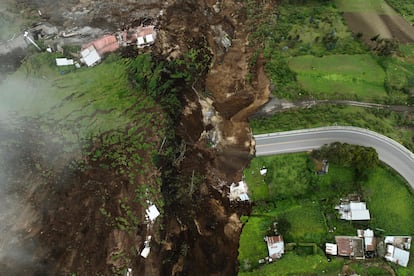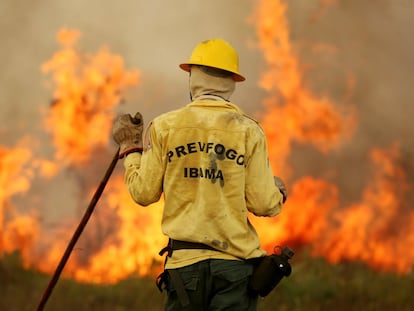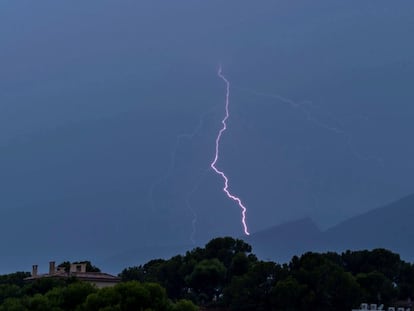The Ecuadorian neighborhood buried by a mountain
Rescuers continue to search for locals buried under the rubble after Sunday’s landslide

The earth made a sound as if it was splitting in two. In a matter of seconds, the mountain completely buried Nueva Alausí, a neighborhood in Chimborazo province in central Ecuador. Tons of earth covered more than 60 houses, all inhabited. It was 9 p.m. on Sunday, March 26. Survivors and locals counted who was missing to get an idea of how many people were under the rubble: the Moina, Ruiz, Berrones, Marcatoma, Guamán, Caranqui and Quisatasi families could not be found. According to the Ecuadorian government, 46 people were buried under the rubble.
David Pilamunga’s 12-year-old son is also missing. He had gone that night to help his mother leave her home, as the risk posed by the mountain was becoming more evident. “In the morning, the crack on top of the mountain had opened up wider and was making the ground crackle,” says David. That sounded the alert to flee, but tragedy struck first. His sister and his four month-old son made it out, but not the 12-year-old. David is searching for him among the rubble, trying to guide rescuers over the mound of earth.
Other neighbors and relatives are helping in the search and rescue of survivors, which is becoming more difficult as the hours go by. As of 9 a.m. Tuesday morning — 36 hours after the landslide — the contingent of rescuers had been reduced to small groups. Most of those searching through the rubble now are the locals themselves.
The Ecuadorian government’s last assessment report was issued at noon on Monday, when they reduced the death toll from 16 to seven without any explanation. Since then, there have been no more updates. When President Guillermo Lasso visited the disaster area Monday night, he was criticized by the families of the victims for not doing enough to prevent the tragedy.
For four months, locals had warned about the crack in the upper part of the mountain and tried to ask the authorities to take action. “Sadly, the two women from Nueva Alausí who fought to stop this from happening are not here,” one of the survivors told Lasso between sobs.
The government recognized the risk and a technical committee was formed to evaluate possible solutions. A yellow alert for a landslide was even declared in the area on February 19. “On March 1, the Minister of Housing sent a letter to the mayor of Alausí, warning him of the risks and proposing as a solution to relocate families in this area,” said Lasso. The solution was to build a housing complex, but disaster struck before the country’s slow-moving bureaucracy was able to complete the project.
“We want justice, everyone told us that the mountain was not going to come down,” the locals yelled at the president on Monday. To which, Lasso replied: “Let’s focus on rescuing the missing, and then we will work out who’s responsible.”
Despite the erroneous message that nothing would happen, María Marcatoma, 65, and her husband were afraid of a potential landslide and decided to rent a room far from their house, which is now ground zero. But that Sunday, she went back to the neighborhood to check up on her things and sell milk, which was her means of living, says Aida, her daughter-in-law, who came from Quito to look for her after she didn’t return.
In Alausí, like many other areas of Ecuador, locals build homes on the slopes of the mountain, sometimes on the very edge or in the middle of it. When pieces of earth fall off around the houses, they put down black plastic to stop the rain from wetting the ground and making it more unstable. It is a way of stopping more pieces from falling off — if only for a short period. The locals then create roads that open the way to the neighborhoods.
Two other communities and four neighborhoods remain under a yellow alert for a possible landslide. It remains to be seen if action will be taken to prevent another tragedy like the one in Nueva Alausí.
Sign up for our weekly newsletter to get more English-language news coverage from EL PAÍS USA Edition
Tu suscripción se está usando en otro dispositivo
¿Quieres añadir otro usuario a tu suscripción?
Si continúas leyendo en este dispositivo, no se podrá leer en el otro.
FlechaTu suscripción se está usando en otro dispositivo y solo puedes acceder a EL PAÍS desde un dispositivo a la vez.
Si quieres compartir tu cuenta, cambia tu suscripción a la modalidad Premium, así podrás añadir otro usuario. Cada uno accederá con su propia cuenta de email, lo que os permitirá personalizar vuestra experiencia en EL PAÍS.
¿Tienes una suscripción de empresa? Accede aquí para contratar más cuentas.
En el caso de no saber quién está usando tu cuenta, te recomendamos cambiar tu contraseña aquí.
Si decides continuar compartiendo tu cuenta, este mensaje se mostrará en tu dispositivo y en el de la otra persona que está usando tu cuenta de forma indefinida, afectando a tu experiencia de lectura. Puedes consultar aquí los términos y condiciones de la suscripción digital.
More information
Archived In
Últimas noticias
Most viewed
- Reinhard Genzel, Nobel laureate in physics: ‘One-minute videos will never give you the truth’
- Oona Chaplin: ‘I told James Cameron that I was living in a treehouse and starting a permaculture project with a friend’
- Pablo Escobar’s hippos: A serious environmental problem, 40 years on
- Why we lost the habit of sleeping in two segments and how that changed our sense of time
- Chevy Chase, the beloved comedian who was a monster off camera: ‘Not everyone hated him, just the people who’ve worked with him’










































